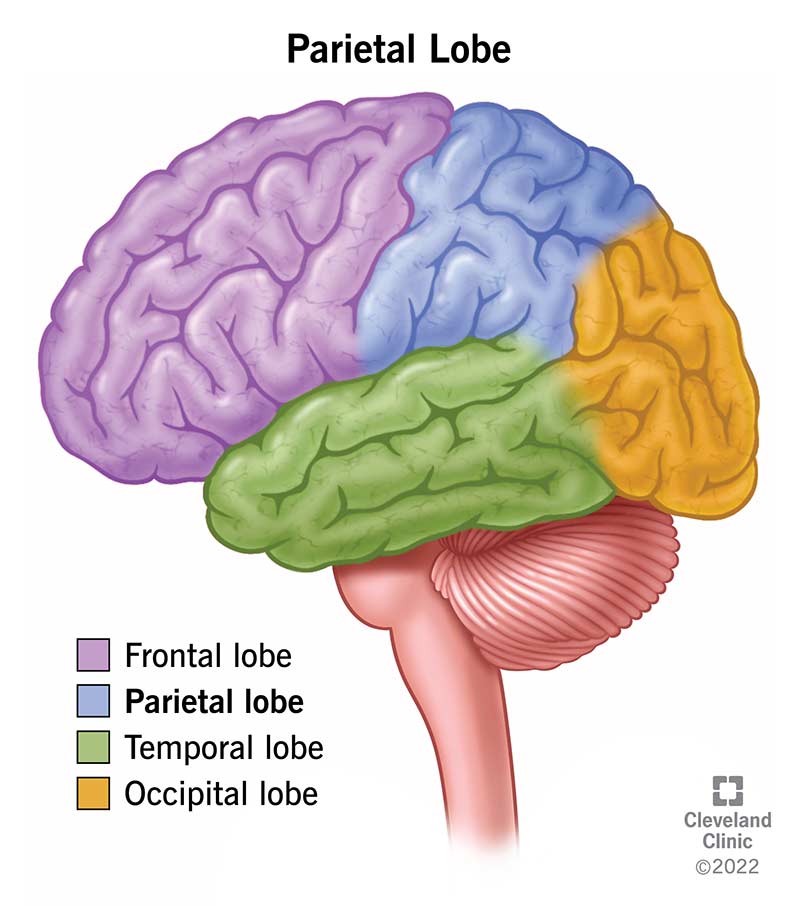Your brain’s parietal lobe is a key part of your understanding of the world around you. It processes your sense of touch and assembles input from your other senses into a form you can use. Your parietal lobe also helps you understand where you are in relation to other things that your senses are picking up around you.
Advertisement
Cleveland Clinic is a non-profit academic medical center. Advertising on our site helps support our mission. We do not endorse non-Cleveland Clinic products or services. Policy

Your parietal lobe is one of your brain’s five lobes. This part of your brain helps many different areas work cooperatively. That cooperation is key to many of the abilities you use in your everyday life. It also contains your brain’s ability to interpret sensations from anywhere on or within your body.
Advertisement
Cleveland Clinic is a non-profit academic medical center. Advertising on our site helps support our mission. We do not endorse non-Cleveland Clinic products or services. Policy
Your brain’s parietal (pronounced “pa-RY-ah-tul”) lobe handles a few different jobs.
Your parietal lobe is a processing center for sensations you can feel with your sense of touch. These include temperature (hot and cold), pressure, vibration and pain.
Self-perception also uses your sense of touch to tell you where parts of your body are without needing to see them (the technical term for this is “proprioception”). A good way to test this is to close your eyes and bring the palm of your hand up to your face. Even with your eyes closed, you can usually tell the approximate position of your hand (and avoid smacking yourself in the face).
Other brain areas process sensory information they’re responsible for, and then forward what they processed to your parietal lobe. Your parietal lobe takes that information, including the self-perception information mentioned above, and integrates it into a form you can understand. It then sends information to other areas of your brain so you can respond (or not respond) to what you sense.
Your parietal lobe also helps you learn each time you plan and carry out complex, precise movements. A big example of this is writing. That’s why writing gets easier with practice. The same is true of similar activities like doing math by hand.
Advertisement
Your parietal lobe plays a key role in how you understand where things are around you. Knowing if something is on your left or right side, for example, is a function that relies on your parietal lobe.
Your parietal lobe is also an important part of “big picture” perception. It helps you process situations when you perceive multiple objects in a related context. An example of this would be seeing a stove, countertops, sink and refrigerator and understanding that you’re looking at a kitchen.
Your parietal lobe is underneath the crown of your skull, at the top rear of your head.
Your parietal lobe makes up about 19% of your brain’s cerebral cortex. “Cortex” is the Latin word for tree bark. The cortex is the wrinkly textured outer surface of your brain, with an average thickness of about 2.5 millimeters.
Your parietal lobe consists of the same specialized cells found throughout your brain. The basic cell types are:
Many conditions and disorders can affect your brain, most of which can affect your parietal lobe. Some of the most common include:
Many symptoms can happen with conditions that affect your parietal lobe. However, some symptoms are more likely or more common, and they usually fall into specific categories.
These abilities involve coordination between your eyes and hands. Examples include:
Advertisement
Symptoms can affect your sense of touch in many ways, including what you can feel or how your brain processes that information. Touch-related symptoms include:
Your parietal lobe helps with your sense of direction relative to the world around you. A major part of that is how you tell left from right, how you orient yourself and parts of your body using your eyesight, and how you understand sensory input from both sides of your body. Symptoms can include:
Advertisement
There are many ways healthcare providers can check the health of your parietal lobe. These include diagnostic tests, lab tests, imaging scans and more. Examples include:
There are many possible treatments for conditions that affect your parietal lobe, and they can vary widely depending on the issue. A healthcare provider is the best person to tell you about the available treatments and which they recommend.
You can do many things to maintain the health of your entire brain, including your parietal lobe. Some brain-related conditions are preventable. Others aren’t preventable, but you may be able to reduce your risk of developing them. Some things you can do to maintain your brain health include:
Advertisement
Your parietal lobe is a key part of how you understand the world around you. It also processes your sense of touch, and it plays an important role in how you control the movement and positioning of your body. While your parietal lobe is at the top of your brain, it’s not always at the top of your mind or something you think about often. Taking care of the health of your entire brain — including your parietal lobe — can make a big difference in your life. That way, you can take in the world around you and prioritize the parts of your life that you value most.
If you have a neurological condition, you want expert advice. At Cleveland Clinic, we’ll work to create a treatment plan that’s right for you.

Last reviewed on 01/08/2023.
Learn more about the Health Library and our editorial process.